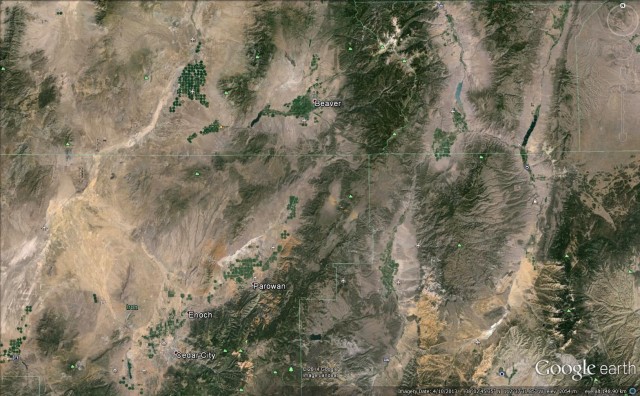17 November 2014
Markagunt: A truly gigantic gravity landslide (2000 cubic kilometres!)
Posted by Dave Petley
The Markagunt gravity slide
In the current edition of the journal Geology, a paper by David Hacker, Robert Biek and Peter Rowley (Hacker et al. 2014) describes the Markagunt gravity slide in southwest Utah. This is a very exciting piece of work as it identifies for the first time a truly gigantic landslide. Whilst I like to avoid superlatives, the scale of the Markagunt landslide is remarkable:
- 90 km long
- 1700 – 2000 cubic kilometres in volume
- Surface area of over 3400 square kilometres
- Up to 200 m thick.
This is part of the area that it covers:
.
The landslide deposit is located in the Marysvale volcanic field in Southwest Utah in the USA. This is not the first time that these landslide deposits have been identified, but previous studies have suggested that they were formed in multiple landslide events, and have termed the deposit the Markagunt volcanic breccia. The change in Hacker et al. (2014) is that the deposit is now recognised as having originated in a single landslide that occurred about 22 million years ago. The paper demonstrates that the landslide consists of a large sheet of volcanic rock broken up by faults. The authors divide the landslide deposit into three distinct sections:
- A 58 x 42 km bedding plane segment;
- A 1-2 km wide ramp segment;
- And a 32 km long land surface segment.
The question of course is how such an enormous landslide can form. The base of the Markagunt gravity slide consists of of a clear shear surface with brecciated (i.e. intensely shattered) rocks. However movement has occurred on a shear surface that has an inclination of only a small number of degrees. The authors suggest that as the Maryvale volcanic field developed, it uplifted the Turshar Mountains, generating a slope in the surrounding rocks. At the base of what was to become the landslide is a very weak volcanic deposits known as the Brian Head formation, allowing sliding to develop.
There is only one other known landslide on this scale – the infamous and equally enormous Heart Mountain Gravity Slide. These two deposits are now the largest subaerial landslides on Earth. Both are of course in the USA; I wonder how many more there are around the world that have yet to be identified?
Reference
David B. Hacker, Robert F. Biek and Peter D. Rowley 2014. Catastrophic emplacement of the gigantic Markagunt gravity slide, southwest Utah (USA): Implications for hazards associated with sector collapse of volcanic fields. Geology 42, 943-946. DOI: 10.1130/G35896.1



 Dave Petley is the Vice-Chancellor of the University of Hull in the United Kingdom. His blog provides commentary and analysis of landslide events occurring worldwide, including the landslides themselves, latest research, and conferences and meetings.
Dave Petley is the Vice-Chancellor of the University of Hull in the United Kingdom. His blog provides commentary and analysis of landslide events occurring worldwide, including the landslides themselves, latest research, and conferences and meetings.